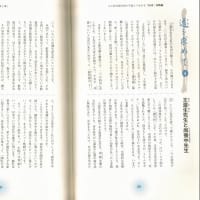セドナメソッドベーシックコース - 7 - 現実を創造(想像する)ためのガイド、 -2
以前の内容:
セドナメソッドベーシックコース - 7 - 現実を創造(想像する)ためのガイド、 -1
初心者は、
具体的な目標をゴールに設定します。
小さな、成功体験を重ねることで、「レスター・レヴェンソンのリリーシング」を信じて、続けていくようになります。
注記:
シルバ・メソッド開発者のホセ・シルバも生前のニュースレターで、大きな目標を設定して成し遂げるよりも、小さな、成功体験を積み重ねることが、結果として大きな成功体験に繋がると書いています。
シルバ・メソッドでは、シルバ・メソッドを使用するときに過去の成功体験を参考点(無意識の)として、次回のシルバ・メソッドに使用します。
完全な自由と悟りの段階 (悟りの階梯) - 0
(2013-08-10 17:17:23 | releasing)
Five Basic Steps to Release Underlying Wants
下にある欲求をリリースする5つの基本的なステップ
(5つの初歩的作法が根本的な欲求をリリースします)
You may do this process on your own by reading the following questions silently to yourself, or do it with the assistance of a partner.
次の質問を静かに黙読することによりこのプロセスを独力で行うか、あるいはパートナーの助けを借りてそれをするかもしれません。
Step 1: Focus on your issue and allow yourself to welcome whatever you are feeling in the NOW moment.
ステップ1:
問題に注目して、あなた自身が、あなたが今瞬間に感じているものすべてを歓迎することを可能にしてください。
Step 2: Dig a little deeper to discover whether the NOW feeling comes from a sense of wanting. Ask one of the following two questions:
ステップ2:
今の感覚が欲しい意味から来るかどうか発見するために、少しより深く掘ってください。
次の2つの質問のうちの1つを尋ねてください(質問をしてください):
• Does the feeling come from wanting approval, control, security, or separation?
• What is the sense of wanting underneath this feeling?
• 感覚は、承認か、支配か、保安か分離を望むことから来ますか?
(感覚は承認、コントロール、セキュリティあるいは分離を望むことから来ますか。)
• この感覚の下に欲しい意味は、何ですか?
(この感覚の真下に不足する感覚は何ですか。)
If you’re not sure which want is underneath the feeling, or if you feel like it may be several wants at the same time―as it often is―pick the one that you feel is dominant, is most likely, or is the one that you’d like to let go of first. Then proceed to Step 3.
本当でない場合、それは不足する、感覚の真下にある、あるいは、それが同時にいくつかの必需品かもしれないように、感じる場合?
それが頻繁なように?
支配的な最もありそうか、あなたが1位に手放したいものである、と思うものを取ってください。
次に、ステップ3に進んでください。
Step 3: Ask yourself one of the following three questions:
• Could I allow myself to want (approval, control, security, or separation)?
• Could I welcome wanting (approval, control, security, or separation)?
• Could I let go of wanting (approval, control, security, or separation)?
When you are releasing on the wants, simplify your questions. After you realize you can let the wants go, you’ll find yourself doing so without a lot of excess thought. Remember “yes” or “no” are both acceptable answers, and you’ll often let go even if you say “no.” Also, if you’d like to, give yourself permission to hold on for a moment before you let go, as this often creates the space for an even deeper release. Partners should keep asking the questions even when they hear a “no” answer. As best you can, answer the chosen question with a minimum of thought. Stay away from second-guessing yourself or getting into a debate about the merits of an action or its consequences. Whatever the response is, move on to the next step.
Please be mindful that you’re not being asked to let go of control, approval, security, or separation, merely to let go of your feeling of lacking them, of wanting.
Step 4: You may use this step at any point during the releasing process to address any feeling, want, or sense of indecision and stuckness. As you learned in Chapter 5, Your Key to Serenity, it is the safety valve of the Method.
Simply ask: Would I like to change that?
The answer will invariably be “yes.” But if you’re not entirely sure, check to see whether you like it the way it is. Any time that something is not okay with you the way it is, this indicates that you want to change it.
Then ask: Could I let go of wanting to change it?
In most cases, even if you are stuck, you’ll be able to answer “yes” to this question. Letting go of wanting to change it will dissolve the stuckness and put you right back on track. As you’ll recall, wanting to change is a subset of wanting to control.
Step 5: Repeat the preceding four steps as often as needed until you feel free of the specific want on which you’re working.
ステップ5:
あなたがどれを動かしているかについて、前の4つのステップが、処理している特定の欲求(欠乏)がないと感じるまで繰り返してください。
Lester believed it was more important to focus on wanting approval, control, and security than on wanting to be separate when we release. He felt that if we were to let go enough of the first three wants, the sense of wanting to be separate would drop away by itself. This was certainly part of his process. Except in this chapter and the next, our releasing
questions throughout most of the book will focus almost exclusively on approval, control, and security. Of course, if you find yourself aware of wanting to be separate, please feel free to let go of this want as well.
レスターは、承認、制御および私たちがリリースする場合に個別になりたいこと (注記:分離の欲求) についてよりも安全を望むことに注目するほうが重要であると信じました。
彼は、私たちが最初に十分に3つの欲求を手放したならば、
個別になりたい感覚 (注記:分離の欲求) は単独で減ると思いました、。
これは確かに彼のプロセスの一部でした。
本章と次以外においては、ほとんどの本の全体にわたる我々のリリースする質問が、承認、制御および安全にほとんど排他的に注目するでしょう。
もちろんあなた自身が個別になりたいことを知っているのを見つける場合 (注記:分離の欲求) に、同様にこの欲求(欠乏)を手放して自由に感じてください。
以前の内容:
セドナメソッドベーシックコース - 7 - 現実を創造(想像する)ためのガイド、 -1
初心者は、
具体的な目標をゴールに設定します。
小さな、成功体験を重ねることで、「レスター・レヴェンソンのリリーシング」を信じて、続けていくようになります。
注記:
シルバ・メソッド開発者のホセ・シルバも生前のニュースレターで、大きな目標を設定して成し遂げるよりも、小さな、成功体験を積み重ねることが、結果として大きな成功体験に繋がると書いています。
シルバ・メソッドでは、シルバ・メソッドを使用するときに過去の成功体験を参考点(無意識の)として、次回のシルバ・メソッドに使用します。
完全な自由と悟りの段階 (悟りの階梯) - 0
(2013-08-10 17:17:23 | releasing)
Five Basic Steps to Release Underlying Wants
下にある欲求をリリースする5つの基本的なステップ
(5つの初歩的作法が根本的な欲求をリリースします)
You may do this process on your own by reading the following questions silently to yourself, or do it with the assistance of a partner.
次の質問を静かに黙読することによりこのプロセスを独力で行うか、あるいはパートナーの助けを借りてそれをするかもしれません。
Step 1: Focus on your issue and allow yourself to welcome whatever you are feeling in the NOW moment.
ステップ1:
問題に注目して、あなた自身が、あなたが今瞬間に感じているものすべてを歓迎することを可能にしてください。
Step 2: Dig a little deeper to discover whether the NOW feeling comes from a sense of wanting. Ask one of the following two questions:
ステップ2:
今の感覚が欲しい意味から来るかどうか発見するために、少しより深く掘ってください。
次の2つの質問のうちの1つを尋ねてください(質問をしてください):
• Does the feeling come from wanting approval, control, security, or separation?
• What is the sense of wanting underneath this feeling?
• 感覚は、承認か、支配か、保安か分離を望むことから来ますか?
(感覚は承認、コントロール、セキュリティあるいは分離を望むことから来ますか。)
• この感覚の下に欲しい意味は、何ですか?
(この感覚の真下に不足する感覚は何ですか。)
If you’re not sure which want is underneath the feeling, or if you feel like it may be several wants at the same time―as it often is―pick the one that you feel is dominant, is most likely, or is the one that you’d like to let go of first. Then proceed to Step 3.
本当でない場合、それは不足する、感覚の真下にある、あるいは、それが同時にいくつかの必需品かもしれないように、感じる場合?
それが頻繁なように?
支配的な最もありそうか、あなたが1位に手放したいものである、と思うものを取ってください。
次に、ステップ3に進んでください。
Step 3: Ask yourself one of the following three questions:
• Could I allow myself to want (approval, control, security, or separation)?
• Could I welcome wanting (approval, control, security, or separation)?
• Could I let go of wanting (approval, control, security, or separation)?
When you are releasing on the wants, simplify your questions. After you realize you can let the wants go, you’ll find yourself doing so without a lot of excess thought. Remember “yes” or “no” are both acceptable answers, and you’ll often let go even if you say “no.” Also, if you’d like to, give yourself permission to hold on for a moment before you let go, as this often creates the space for an even deeper release. Partners should keep asking the questions even when they hear a “no” answer. As best you can, answer the chosen question with a minimum of thought. Stay away from second-guessing yourself or getting into a debate about the merits of an action or its consequences. Whatever the response is, move on to the next step.
Please be mindful that you’re not being asked to let go of control, approval, security, or separation, merely to let go of your feeling of lacking them, of wanting.
Step 4: You may use this step at any point during the releasing process to address any feeling, want, or sense of indecision and stuckness. As you learned in Chapter 5, Your Key to Serenity, it is the safety valve of the Method.
Simply ask: Would I like to change that?
The answer will invariably be “yes.” But if you’re not entirely sure, check to see whether you like it the way it is. Any time that something is not okay with you the way it is, this indicates that you want to change it.
Then ask: Could I let go of wanting to change it?
In most cases, even if you are stuck, you’ll be able to answer “yes” to this question. Letting go of wanting to change it will dissolve the stuckness and put you right back on track. As you’ll recall, wanting to change is a subset of wanting to control.
Step 5: Repeat the preceding four steps as often as needed until you feel free of the specific want on which you’re working.
ステップ5:
あなたがどれを動かしているかについて、前の4つのステップが、処理している特定の欲求(欠乏)がないと感じるまで繰り返してください。
Lester believed it was more important to focus on wanting approval, control, and security than on wanting to be separate when we release. He felt that if we were to let go enough of the first three wants, the sense of wanting to be separate would drop away by itself. This was certainly part of his process. Except in this chapter and the next, our releasing
questions throughout most of the book will focus almost exclusively on approval, control, and security. Of course, if you find yourself aware of wanting to be separate, please feel free to let go of this want as well.
レスターは、承認、制御および私たちがリリースする場合に個別になりたいこと (注記:分離の欲求) についてよりも安全を望むことに注目するほうが重要であると信じました。
彼は、私たちが最初に十分に3つの欲求を手放したならば、
個別になりたい感覚 (注記:分離の欲求) は単独で減ると思いました、。
これは確かに彼のプロセスの一部でした。
本章と次以外においては、ほとんどの本の全体にわたる我々のリリースする質問が、承認、制御および安全にほとんど排他的に注目するでしょう。
もちろんあなた自身が個別になりたいことを知っているのを見つける場合 (注記:分離の欲求) に、同様にこの欲求(欠乏)を手放して自由に感じてください。






















